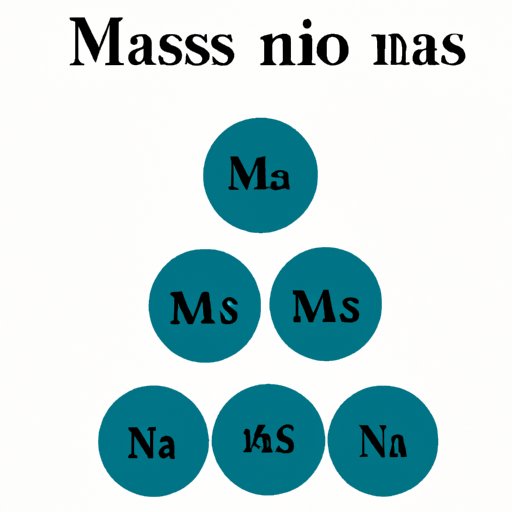Introduction
Have you ever wondered how scientists measure the mass of an atom? Or why mass number is important in nuclear chemistry? Mass number is a concept that is crucial in understanding atomic science and the behavior of elements. In this article, we will provide a comprehensive guide to help beginners learn more about the mass number of an element and how it relates to atomic structure.
Understanding the Mass Number: A Complete Guide for Beginners
The mass number is defined as the sum of the number of protons and the number of neutrons in an atomic nucleus. It is represented by the letter A. In other words, the mass number measures the total number of particles in the nucleus of an atom.
The mass number is an important concept in atomic science because it provides information about the stability and isotopic composition of an element. By knowing the mass number of an element, scientists can predict its behavior and understand its properties.
Calculating the mass number of an element is simple. To calculate the mass number, you add the number of protons and neutrons in the nucleus of the atom. For example, the mass number of oxygen-16, which has 8 protons and 8 neutrons, is 16.
Knowing the mass number of an element is important because it can tell you the number of neutrons present in the nucleus. This is important because atoms with different numbers of neutrons can have different properties and behaviors. For example, carbon-12 has 6 neutrons, while carbon-14 has 8 neutrons. Carbon-14 is radioactive and is commonly used in radiocarbon dating, while carbon-12 is stable and is commonly used in organic chemistry.
Demystifying Mass Number: A Simple Breakdown
The mass number can be further broken down into isotopes. Isotopes are atoms of the same element that have different numbers of neutrons. Isotopes have the same number of protons, but different mass numbers and atomic masses. For example, carbon-12 and carbon-14 are isotopes of carbon with different mass numbers.
Isotopes are important in atomic science because they can have different properties and behaviors. Some isotopes are radioactive, meaning they decay over time and give off radiation. Other isotopes are stable and do not decay.
Many elements have multiple isotopes, each with its own mass number. For example, the element chlorine has two important isotopes: chlorine-35 and chlorine-37. Chlorine-35 is more common and has a mass number of 35, while chlorine-37 is less common and has a mass number of 37.
The Importance of Mass Number in Atomic Science
Mass number is crucial in many fields of atomic science, including nuclear chemistry. Nuclear chemistry involves the study of the behavior of atomic nuclei, including how they undergo radioactive decay and fusion. Understanding the mass number of an element is important in predicting how it will behave in nuclear reactions.
Additionally, mass number is important in fields such as medicine and energy production. Radioactive isotopes are commonly used in medicine for diagnostic imaging and cancer treatment. Understanding the mass number of these isotopes is crucial in order to use them safely and effectively.
Mass Number vs Atomic Number: What’s the Difference?
The atomic number is the number of protons in an atom, and is represented by the letter Z. The atomic number is important in identifying the element, and is used to organize the elements on the periodic table. The mass number, on the other hand, is the total number of protons and neutrons in the nucleus of an atom.
While both the atomic number and mass number are important in atomic science, the atomic number is more important in identifying elements, while the mass number is more important in predicting the behavior of isotopes and understanding nuclear reactions.
An In-Depth Look at the Calculation Method of Mass Number
Calculating mass number requires knowledge of atomic mass and atomic number. Atomic mass is the average mass of all of the isotopes of an element, weighted by their abundance. Atomic number is the number of protons in an atom.
To calculate the mass number of an element, you can use the following formula:
Mass number (A) = number of protons (Z) + number of neutrons (N)
For example, the mass number of carbon-12, which has 6 protons and 6 neutrons, can be calculated as follows:
Mass number = 6 protons + 6 neutrons = 12
Calculating the mass number of isotopes with different numbers of neutrons is similar. For example, the mass number of carbon-14, which has 6 protons and 8 neutrons, can be calculated as follows:
Mass number = 6 protons + 8 neutrons = 14
If you know the atomic mass and atomic number of an element, you can calculate the number of neutrons and the mass number. For example, if the atomic mass of an element is 35 and its atomic number is 17, you can calculate the number of neutrons and the mass number as follows:
Number of neutrons = atomic mass – atomic number = 35 – 17 = 18
Mass number = atomic number + number of neutrons = 17 + 18 = 35
Conclusion
Mass number is an important concept in atomic science, and understanding it is crucial in fields such as nuclear chemistry, medicine, and energy production. By knowing the mass number of an element, scientists can predict its behavior and understand its properties. We hope that this comprehensive guide has provided a clear and simple explanation of what mass number is, how to calculate it, and why it is important.
